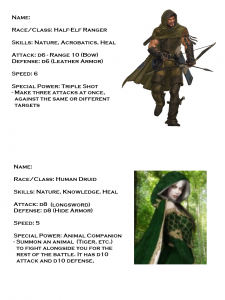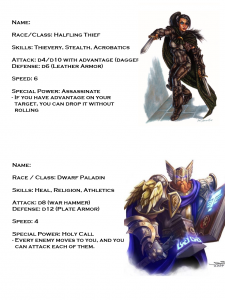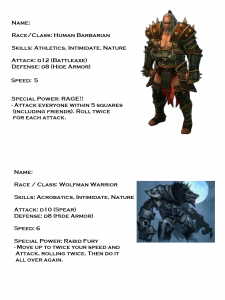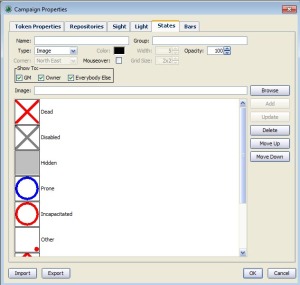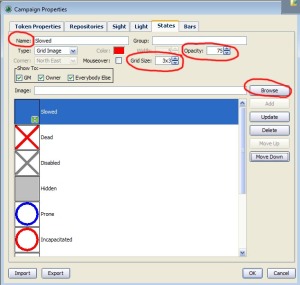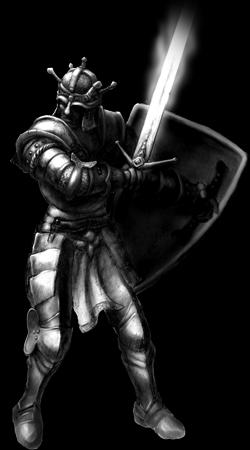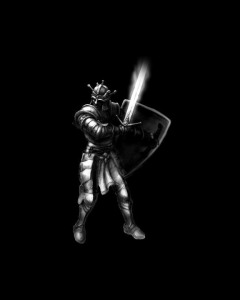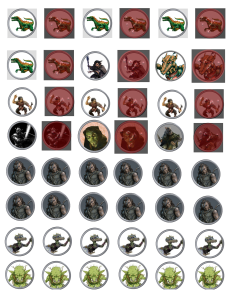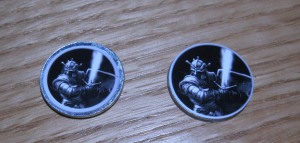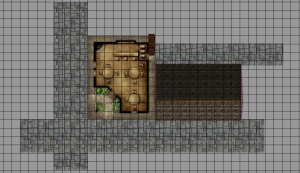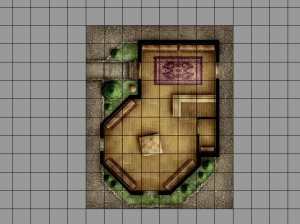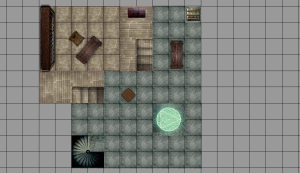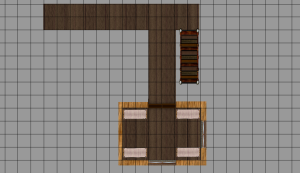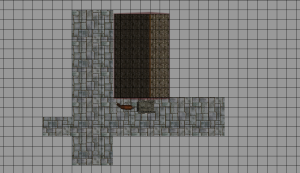For Christmas 2010, my wife’s brother and his family stayed with us for a couple of weeks. We introduced my brother in law and his wife to Dungeons & Dragons, and they became big fans, continuing our game online via MapTool over the next couple of years.
My brother in law’s family also includes two kids, a girl who is currently 8 years old and a boy who is now 5. They’ve been really interested in D&D, so when the family came back to visit for Christmas 2012, I knew it was time to introduce them to role playing games.
Now, I love playing D&D 4th Edition, but I knew that there was no way my 8 year old niece and 5 year old nephew would be able to handle the game yet. I went searching for a version of D&D that could work for the children, and I took a great deal of inspiration from Newbie DM’s RPG Kids. Ultimately, though, I ended up going with something of my own creation, which I’m uncreatively calling my Kid-Friendly RPG (KFRPG if you need an acronym).
The rules
Each player has a half-page character sheet (see below). When you’re not in combat, the Kid-Friendly RPG works just like any other role-playing game – you tell the game master what you want to do, and the GM tells you what happens.
Character sheets
Feel free to use these character sheets yourself (note that there are two characters per page). I’ll note here that I do not own the character illustrations; if you own these illustrations and want me to take them down, just let me know. If you’re creating your own character sheets, I highly recommend having a big picture of the character on it for the kids.
Skills
If a character tries something that might not work, the GM will ask for a d20 roll. In most cases, a 10 or better will succeed, but the GM is free to set the target higher or lower for harder or easier tasks.
If the character is trying to do something that’s connected to one of the three skills on their character sheet, they can roll the d20 twice and take the best result.
Combat
When combat breaks out, the party chooses a player to roll a d20 and the GM rolls a d20. If the party’s representative wins, their team will go first. If the GM wins, the bad guys will go first. Ties go to the party (ties always go to the players rather than the GM).
Rather than tracking initiative, each member of the party takes a turn, starting with the player to the GM’s left and proceeding clockwise around the table. The GM has the monsters take their turns in whatever order the GM wishes.
On a character’s turn, the character can move up to its speed (measured in squares on the board) and take an action. Most of the time, the action will be an attack, but other options include administering a healing potion to themselves or a friend, using a special power or trying something creative.
Attacking and Defending
Each character has an Attack die and a Defense die, ranging from d4 to d12. When you make an attack, roll your Attack die. Your target will roll its Defense die. If a player character’s Attack roll matches or beats the enemy’s Defense roll, the enemy takes 1 damage. Most enemies only have 1 hit point, so this is usually enough to take the enemy out.
When an enemy attacks a player character, the enemy rolls its Attack die and the player rolls the character’s Defense die. If the Defense roll is at least as high as the Attack roll, then the attack misses. If the Attack roll from the enemy is higher, then the player character takes 1 damage.
Note that in both cases, Attacking and Defending, ties go to the player character. So, if the player is attacking and rolls a 3 and the defender rolls a 3, it’s a hit on the enemy. But if an enemy is attacking a player character and they both roll a 3, it’s a miss on the player character.
Hit points
Each player character starts with 3 hit points, which are tracked with some kind of physical object (I use red poker chips). When the character takes damage, the player gives one of these chips to the GM. If the player has no more hit point chips, then the character is knocked out (not dead, just not able to act).
Healing
Each character starts with 1 healing potion, tracked with a green poker chip. One of the actions available in combat is to drink the healing potion or administer it to a friend. If a character drinks their own healing potion, they regain 1 hit point (the GM gives back a red chip). If a character administers it to a friend, the friend regains 1 hit point. However, if a character has the Heal skill and administers the potion to a friend, the friend regains 2 hit points. Note that a character with the Heal skill who drinks his or her own potion still just gets the 1 hit point (your Heal skill only helps friends).
If a character is knocked out, a character with the Heal skill can use an action in battle to try to heal the knocked out character, even without a healing potion. The healer can roll the d20 twice, and if they get a 15 or better, the knocked out character regains 1 hit point. A character without the Heal skill can try this, too, but they only get one roll and still need a 15 or better.
If a battle ends with one or more player characters knocked out, those characters regain 1 hit point after laying there for a few minutes.
Special Powers
Each character has a special power, which starts charged up. This is represented by a blue poker chip. If the player wants to use his or her character’s special power, they give the blue chip to the GM and then carry out the instructions.
Range of attack
Most attacks are melee attacks, which means that the character needs to be next to the target. If a Range is specified, the character can be that many squares away from the target and can still attack.
Advantage
If two player characters are both adjacent to an enemy, they have the advantage on that enemy (they do not need to be in flanking positions, just both adjacent). A player character with the advantage gets a one-size bigger die for attacks (if the attack die is a d12, just add 1 to the result of the roll). Having advantage doesn’t help on defense.
Enemies can benefit from advantage at the GM’s discretion (a good rule of thumb is that you need 3 or 4 adjacent enemies to get advantage for them).
Movement
Each character has a Speed number, which is the number of squares they can move on a turn in addition to taking an action. The default is 5, with fast characters having 6 and slow characters having 4.
If a character doesn’t take another action, they can move their speed twice on a turn.
Enemies
Most enemies have 1 hit point and a d6 for both attacking and defending, and they only attack in melee. They do not have special powers or healing potions.
A tougher or easier enemy might have bigger or smaller dice for attacks or defense. They might have a ranged attack (generally with a range no more than 5 squares). They might have a slight twist to their attack, such as an attack that grabs a character and doesn’t let it get away until the enemy is destroyed.
A boss enemy might have 3 hit points and a special power, just like a character (though no healing potions).
Optional rule: Charging
If a character wants to charge a far-off enemy, the character can move its speed and then move its speed again with an attack at the end of the second move. This attack uses a die that’s one size smaller than the character’s usual attack die (since it’s hard to attack while running).
Optional rule: Opportunity attacks
If you want to teach your players about tactical movement, you can rule that moving past an enemy without fighting it will let the enemy take a free attack at the character (which can work both ways for player characters and enemies).
Tah-dah!
So, that’s the game. I ran this with two kids and three adults (which later ballooned to five adults as more people joined in). We played a short adventure that involved three fights and a trap (note: the kids just didn’t get the trap at all), plus a bunch of role playing at the tavern at the beginning. The game lasted somewhere between an hour and a half and two hours. The kids had a blast, as did I. The rules are simple and they encourage lots of improvisation all around.
If you end up trying this out with your own group of kids, please let me know how it goes!
-Michael the OnlineDM

